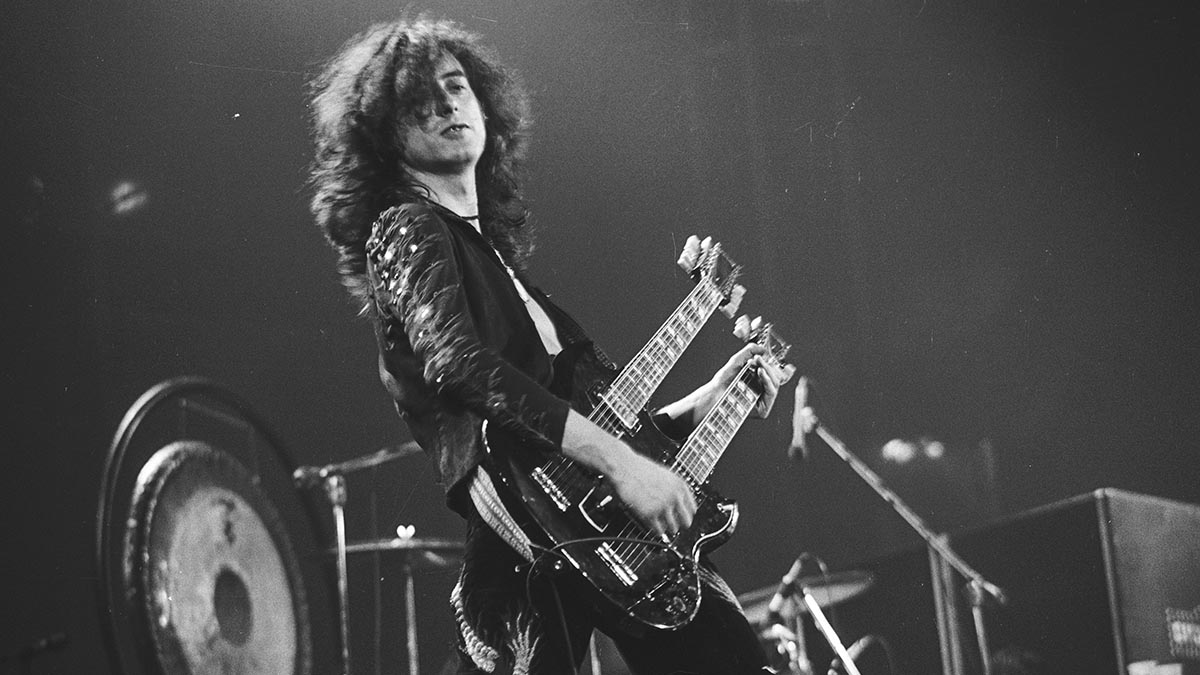The ultimate Jimmy Page guitar lesson: learn every aspect of the Led Zeppelin legend’s playing
Take a deep dive into the electric and acoustic techniques of one of the most influential blues, rock and folk guitarists of all time – and learn to incorporate them in your own style

In this article, we aim to identify many of Jimmy Page’s key techniques and innovations from his Led Zeppelin period, with a view to incorporating these ideas in your own style.
Page’s early recordings featured him mostly using a Fender Telecaster. However he is arguably most associated with the classic combination of his sunburst 1959 Gibson Les Paul (named Number 1) plugged into a Marshall stack. Other guitars such as the black Danelectro 3021 and the double-neck Gibson EDS-1275 are also iconic additions to the arsenal.
Jimmy’s vibrato and string bending technique are very much at the heart of his style. His fiery approach often puts the emphasis on feel and attitude over clinical precision. However, the overall effect sounds exciting, evocative and musical.
Jimmy often includes large string bends in his solos (tone-and-a-half and even two-tones!). He also often bends all the minor 3rds in the scale slightly sharp. These quarter-tone bends help the notes to fit and also adds a dirty blues-rock flavour. If you then incorporate his finger vibrato and bending styles with shape one of the minor pentatonic, the results will immediately start to sound very ’70s blues-rock.
To give you a chance to try out some JP-flavoured ideas, we have recorded four jam tracks complete with tabbed performances.
Our first jam is a fast-paced romp that draws inspiration from the band’s first two albums. Jimmy was a master of riff writing and these were often built from pentatonic scales and the blues scale with its b5 note. The soloing is frenetic blues-based rock and showcases some of Jimmy’s favourite concepts, such as repetitive phrases and large, ear-grabbing string bends.
The second track is a slow blues number inspired by songs like I Can’t Quit You Babe and Since I’ve Been Loving You. Page had an authentic-sounding blues approach, very much in the Peter Green vein, yet still left plenty of room for his own unique approach and interpretation to shine through.
All the latest guitar news, interviews, lessons, reviews, deals and more, direct to your inbox!
Page is an accomplished acoustic guitarist, too, and both six and 12-string acoustics are put to good use in Led Zep’s back catalog. Therefore, our third jam track is inspired by big strummers like That’s The Way, and altered tuning acoustic classics such as Black Mountain Side. We are using DADGAD tuning, which has always been one of Jimmy’s favourites.
Our fourth and final jam track is a finger-picking workout in the style of big ballads such as Babe I’m Gonna Leave You and the radio classic Stairway To Heaven. Jimmy is an excellent fingerstylist, so it would be remiss not to have a bit of acoustic fingerpicking in here, too.
Get the tone
Amp settings: Gain 7, Bass 7, Middle 8, Treble 7, Reverb 4
A common mistake that many people make when going for a Page-like sound is to pile on the preamp gain. That is not the way to emulate the power and ferocity that a screaming tube amp makes. Overdrive softens the tone so opt for a loud, clean tone just pushing into distortion. Add light drive from a pedal if you like, but don’t swamp the basic note. Add effects to taste.
Track 1. A Whole Lotta Rock
Our first jam track is a fast-paced romp that draws inspiration from the first two albums with their more organic, less produced sound [Verse 1-2: Bars 1-18] The track starts out with a riff that combines palm muting on the sixth string and chord stabs.
JP was one of the first rock guitarists to use the palm muting technique to beef up his riffs. Aim to use down-picking throughout as this will help to maintain that even sounding, driving attack. E Blues scale (E-G-A-Bb-B-D) is used to create the fills. There’s a never-ending font of great sounding riffs waiting to be discovered within the notes of this scale.
[Bridge: Bars 19-26] The bridge section uses the classic rock and roll riff combined with barre chord stabs. The barre chord can be held in place and then the fretting hand fourth finger used to add the note on the fifth string.
[Solo: Bars 27-end] We start with a classic JP repeating phrase. This combines string bending on the third string and a pull-off on the second. There is a great bend to negotiate in bar 30 so be prepared for this. Jimmy often uses open strings to pull off onto and in bars 39-41 we see an ascending chromatic pattern. The solo finishes with a blues scale riff that’s played in unison with the bass guitar.
Track 2. Slow Blues
Our second track is a slow blues number inspired by songs like I Can’t Quit You Babe and Since I’ve Been Loving You [Chorus 1: Bars 1-13]
This solo uses the A Minor Pentatonic scale as a roadmap. In the trio format chords can be included in a question and answer fashion and this helps provide both accompaniment and musical dialogue. Again there are some big string bends to navigate in here so be sure to warm up if you’re not used to these.
[Chorus 2: Bar 14 -end] The second chorus starts with a strummed A9 chord that build to a crescendo. [Bars 16-17] This repeating fast phrase is a classic Jimmy Page trademark. [Bar 19 and Bar 24] The unison bends help to beef up the notes; players like Jimi Hendrix were also fond of using these.
Track 3. The DADGAD Strummer
Our third jam track is inspired by Led Zeppelin acoustic favourites and we are in DADGAD tuning. [Section A: Bars 1-11] This track starts with full, six-string harmonics played above the 12th, 7th and 5th frets.
The first strumming section exploits the DADGAD tuning and allows for a one-finger melody to be played on the third string. On the repeat we beef up this melody by adding in a chord behind it. A light pick (under 1mm) is best as it evens out the percussive attack.
[Section B: Bars 11-20] In section B, we add in the B Minor chord to provide some variety. To save space, we have used repeat marks and a first and second time bar.
[Section C: Bars 21-26] For this section, the Csus2 chord provides a shift in mood. The 12-string guitar can be a bit of a beast to work with so all of the chords here are relatively easy to finger (you can always use your six-string).
[Section D] For the final section we reprise the main melody from section A.
Track 4. Acoustic Fingerpicking
Our fourth and final jam track is a fingerpicking workout in the style Babe I’m Gonna Leave You and Stairway To Heaven. For this one, we are back in standard tuning (EADGBE).
[Intro: Bars 1-5] The picking pattern starts with a pinch between the thumb and third finger, followed by second and first-finger plucking. For clarity we have written the picking pattern in the notation.
[Verse 1: Bars 6-9] The picking pattern from the intro section remains the main crux of the piece. The only elements that change in the verse are the location of the bass note and also which group of three strings is being used.
Jon Bishop is a UK-based guitarist and freelance musician, and a longtime contributor to Guitar Techniques and Total Guitar. He's a graduate of the Academy of Contemporary Music in Guildford and is touring and recording guitarist for British rock 'n' roll royalty Shakin’ Stevens.

